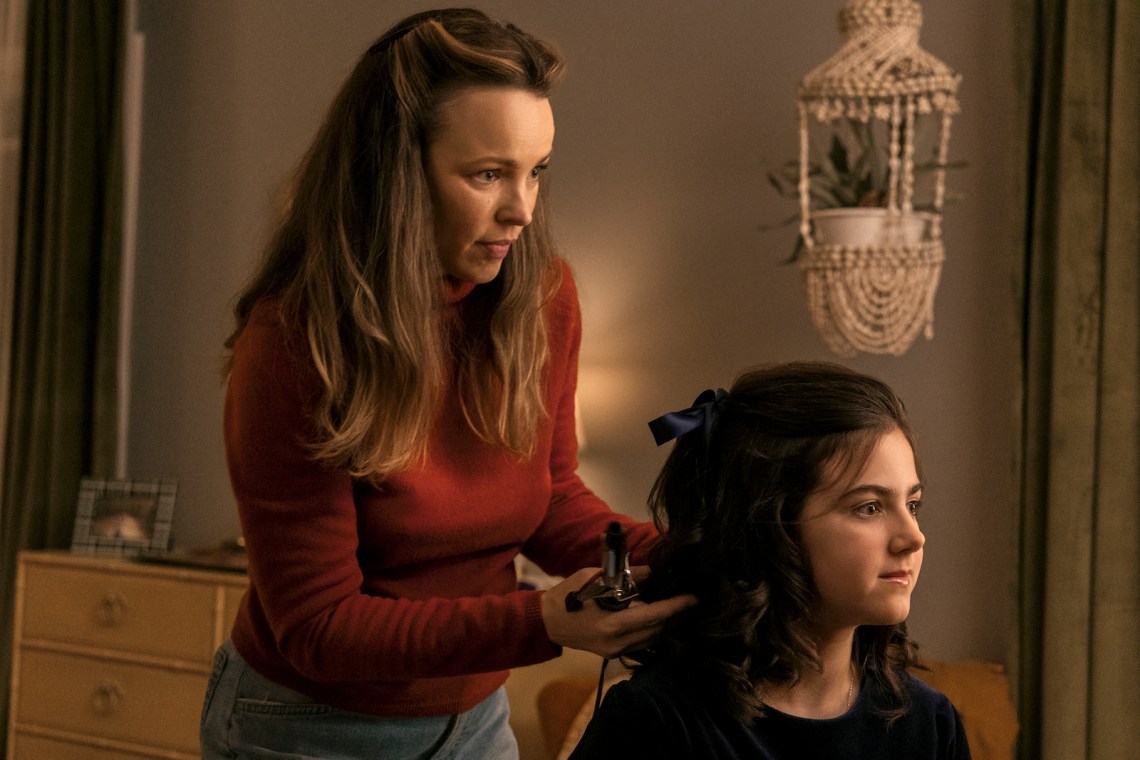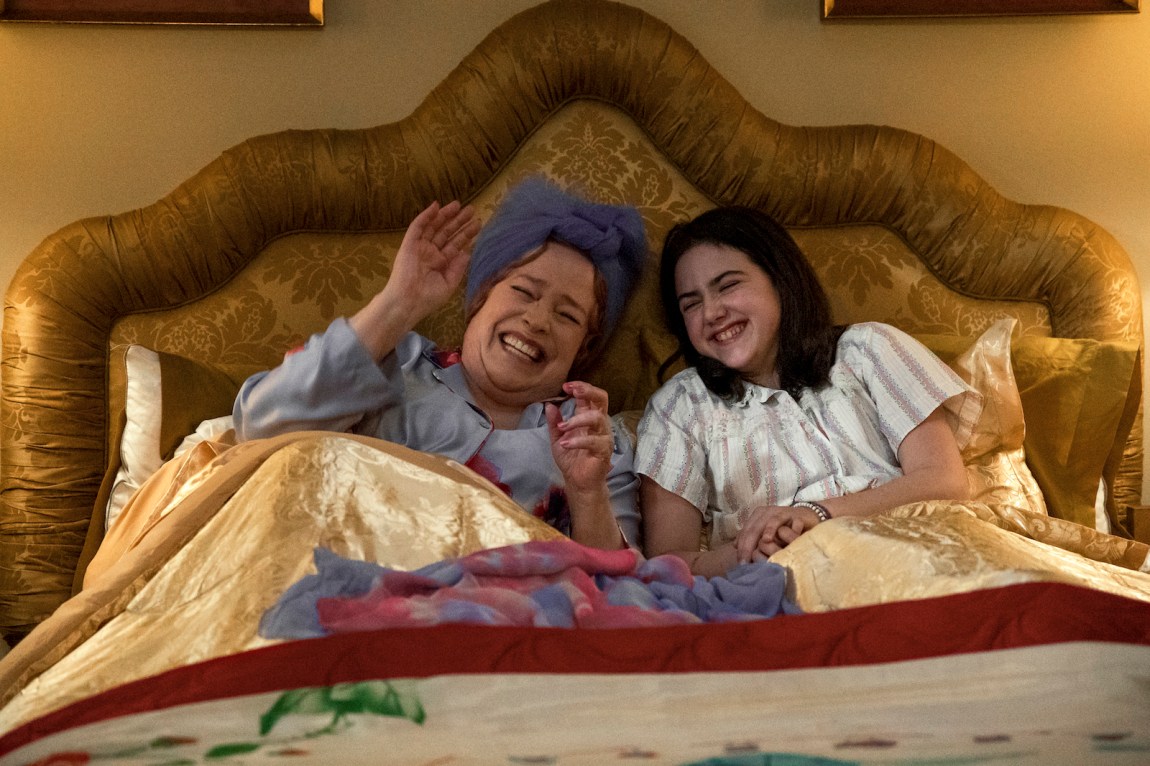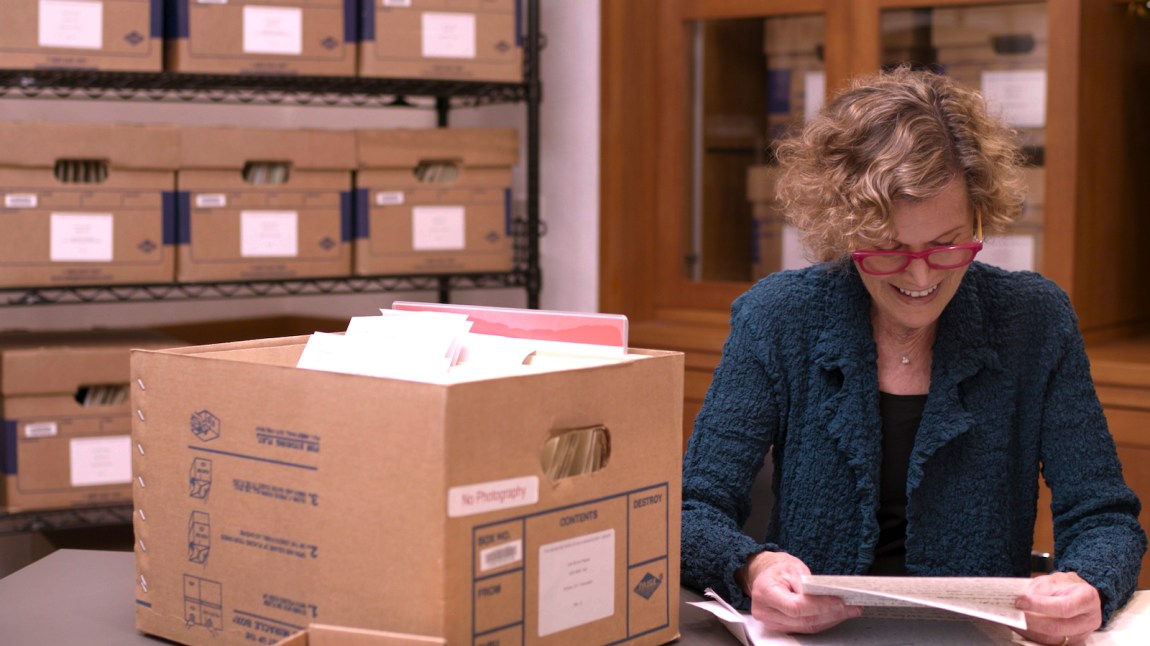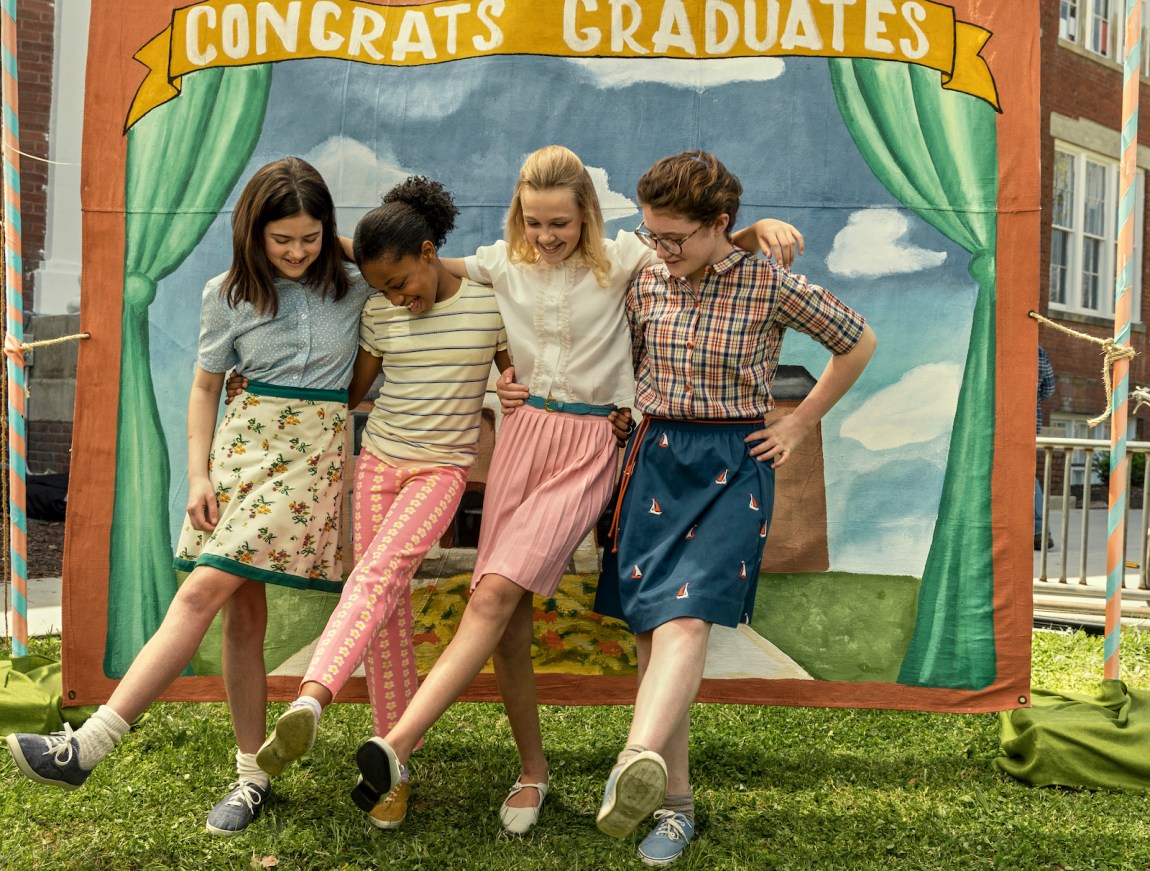I am not the sort of woman who cries alone in a theater while watching a children’s movie. Watching the first and long-awaited film adaptation of Are You There God? It’s Me, Margaret. at a London theater in June, my tears fell automatically, as if my eyes were sweating. I actually wondered if I was having an allergic reaction to the upholstery.
Judy Blume’s best-selling 1970 book for young readers follows the sixth-grade year of Margaret Simon, a white, middle-class girl whose parents have just moved her from Manhattan to the New Jersey suburbs. Margaret is on the cusp of puberty, anxiously anticipating her menarche (a word I learned from that other famous chronicler of adolescence, Muriel Spark) and nascent breasts, and overwhelmed by her family’s translocation. Her father and beloved grandmother are Jewish while her mother was raised Christian, and Margaret has been tasked with choosing her own religion when she grows up. After Margaret’s parents inform her of the move she starts talking to God, requesting support, and investigating the proffered avenues of faith.
The movie is an immaculate period piece, with feathered haircuts, high-waisted jeans, and opening credits in a thick yellow Seventies font. In interviews Blume has said that the director-writer Kelly Fremon Craig’s adaptation surpasses her book. The novel is in the first person, every moment and character filtered through the assessments of its eleven-year-old protagonist, but I marveled at how the film, despite its faithfulness to the plot, appealed to my adult sensibility. Though Margaret’s experience remains central, the distance imposed by the camera’s lens adds a rich layer of dramatic irony to the story. In one scene Margaret and a friend decide to purchase sanitary pads from their local pharmacy. As they approach the checkout counter, the older woman cashier is replaced by a desultory young man. The girls balk but continue and place the pastel boxes of Teenage Softies on the conveyor belt. Instead of reaching for it, the cashier activates the belt and all three characters stare alternately at each other and at the pads as the belt inches forward, creaking. Finally, unable to bear the excruciating awkwardness, Margaret throws a box of mints on top of the Teenage Softies. It is pitch-perfect. Where the book delivers scenes like this straight, as earnest and believable representations of pubescent mortification, the film brings them a wise and warm humor. At many points I laughed through my tears. It is a poignant, accurate portrait of what many consider “ordinary” adolescence.
My tears intensified later in the film when Margaret attends a birthday party with her entire class, and the children play spin-the-bottle, followed by “two minutes in the closet.” Unlike many movies with young characters, the actors in Are You There? actually look their age. They are giddy at the prospect of a coed party but naive when it comes to these classic games of sexual experimentation. Anxiety, Margaret’s emotional high note throughout the scene, is played for laughs. Near the end of the game, she is paired with the middle-school lothario Philip Leroy for a round in the closet. Dusty Springfield’s “Son of a Preacher Man” starts playing as she stands. After a few pecks, the scene cuts to church bells ringing as Margaret accompanies a friend to Christmas services. I swabbed my face with a tissue covertly so the woman seated near me wouldn’t notice.
*
I was a fanatical reader as a child, more in the spirit of Jim Carroll in The Basketball Diaries than Tracy Flick, which is to say that I brought to reading the same rapacious appetite I later exhibited for heroin. I gobbled books indiscriminately, everything from Greek myths to The Baby-Sitters Club to Valley of the Dolls, but reread only a few. These I returned to with the devotion of B. F. Skinner’s rats, nosing the levers of their narratives to release the pleasure they promised. There was no book I read more often than Are You There God? It’s Me, Margaret. It was almost twenty years old when I encountered it, but still more candid about bodily changes and the feelings they prompted than any other children’s book I had read. I was eight, nine, and ten years old during the years I returned to it and, like many pre-teens, obsessed with my imminent development. The book was part manual, part mirror. Margaret is mortified to change into a bathing suit under the gaze of her friend, self-conscious about her flat chest, and keenly aware of her peers’ anxieties, too. Blume named many feelings that I recognized and prescribed some that I anticipated. Sometimes the distinction between these blurred.
Like Margaret, I had parents who weren’t like those of my peers; I knew of no other Puerto Rican sea captains or feminist psychotherapists in our town, and no one else I knew had been raised vegetarian. My mother was a Buddhist who took her bodhisattva vows when I was in middle school, and my father sometimes brought me and my brother to the local Unitarian congregation, although no religious observance was required of us. I, too, was a spiritually seeking child with a doting grandmother who would have liked to convert me. Margaret has her adoring Jewish Grandma (played to the nines by Kathy Bates), who lives in Manhattan and specializes in caftans and guilt-trips, while I had my tiny, Bronx-bred Abuela, an ardent fan of Julio Iglesias and Rosie Perez who took me to Catholic Mass and to see the Rockettes at Christmastime.
Advertisement
The rituals of Mass appealed to me, and as a secretive child I loved the idea of confession, but I didn’t sense God in those churches. My parents had both grown up in Jersey, but they raised us in coastal Massachusetts. My church was steepled with pine trees, my holy basin the kettle-hole pond that I swam in all summer. In Catholic church everything felt heavy and slow, but in the water my changing body became weightless. Sometimes I would gulp an enormous breath and dive below the surface, where my vision blurred, and scream into the water.
My parents had answered all my questions about puberty and sex when I first asked, around the age of seven or eight, free of shame or euphemism. Confiding in them about my feelings when the changes arrived, however, felt impossible. Not because I didn’t trust them, but because despite their reassurances there seemed a significant likelihood that I was the only child who felt what I felt. There was tremendous comfort in Margaret, who kept me company in many of my anxieties and promised that I would mature alongside my peers, and might even greet my first period with elation.
But there were feelings that the book did not name. At ten and eleven I had a burgeoning sense of the erotic, an almost scientific anatomical curiosity, and a healthy dose of existential dread. I encountered reference points for these feelings in the adult novels I consumed, by Pat Conroy, Stephen King, and Susan Isaacs, which I found on my parents’ shelves and in the public library. Later, I found even better examples by queer women novelists like Jeanette Winterson. But I never read about them in any children’s book (I was late to Blume’s more sexually frank young adult novels, Forever… and Tiger Eyes). I wasn’t even sure I could find the words for my feelings. I already understood instinctively that the act of naming made experience material. So I spoke of these feelings to no one and suspected that they made me an outlier, precocious in ways that my peers would consider perverse. “Oh please God,” Margaret prays, “I just want to be normal.”
*
Judy Blume Forever, a biographical documentary released this year by Amazon Studios, paints Blume in a deservedly heroic light. In talking-head interviews, luminaries like the actress Molly Ringwald and a host of contemporary authors of young adult fiction arrive at a consensus that Blume’s frank and humane depictions of her young characters changed innumerable lives, as well as the field of children’s literature. We see some of the copious fan mail that Blume has been receiving from young readers for the last fifty years. “Dear Judy,” one writes, “I would like to know, if you know, if I’m a normal fifth grader.”
It had never occurred to me to write to her, or any author, but as Blume acknowledges in the documentary, it is sometimes easier to confide in a stranger than in one’s parents. In letters and interviews her readers passionately express their gratitude to her for naming their unspoken feelings and experiences. One little girl maintained such an avid correspondence with the author that Blume eventually attended her high school graduation. For some she was their primary source of education about sexual development, from bodily changes to erotic desire, and for many more she was the sole proof that these topics need not be treated with shame.
Are You There God? now seems tame next to contemporary young adult novels, but it was on the vanguard at the time of its publication for its candid exploration of menstruation and Margaret’s earnest attempts to choose her own religion. Like many other Blume titles, it has been frequently cited on lists of banned books over the past fifty years. Amid the rising conservatism of the Reagan era, Blume became a target for people looking to expunge any mention of sexuality or sexual anatomy from children’s literature. She was berated on television by Pat Buchanan, who accused her of being obsessed with children’s masturbation on the basis of a handful of sentences in Deenie, a novel about a teenager with scoliosis. Phyllis Schlafly released a pamphlet: “How to Rid Your Schools and Libraries of Judy Blume Books.” Blume has said that her own children’s elementary school refused to carry Are You There God? due to its discussion of menstruation. As conservatism rises again, in much the same mold, censorship has resumed. This past spring a school system in Florida banned Forever…, Blume’s 1975 novel that follows two high school seniors in a committed relationship as they navigate the decision to have sexual intercourse.
Advertisement
One of the ways that Blume has said Craig’s film improves upon the novel is by including a storyline for Barbara Simon, Margaret’s mother, a painter and school art teacher who uses the occasion of their move to transition into stay-at-home parenting. She joins the PTA and attempts to take a more active role in Margaret’s life, to mixed results. Margaret clearly doesn’t need her mother’s full attention, and Barbara’s creative instincts are wasted on PTA committee projects. By the film’s end, she returns to teaching. This subplot subtly adds a feminist dimension to Margaret’s story that reflects the politics of the time better than the book.
Like Barbara, played by Rachel McAdams, my mother was beautiful and creative. Though an attentive parent, she had no time for the PTA. She would never have cut out a thousand felt stars to glue on the gymnasium ceiling, as Barbara reluctantly does in the film, but she did sing me protest songs by Holly Near and Joan Baez as lullabies and teach me how to use the contents of her toolbox. This education was fundamental to the person I have become, but it couldn’t stanch the tide of contrary messaging from teen magazines and, most influentially, my peers that arrived as I approached puberty. My sex education was no better than the PTA-sponsored educational film Margaret’s class watches—What Every Girl Should Know, which consists almost entirely of a diagram illustrating menstruation. I assume the title must be a wink from Blume, cribbed from Margaret Sanger’s 1916 text that defied obscenity laws by candidly describing sex, reproduction, and sexually transmitted infections.
I might have been capable of drawing an accurate diagram of the female reproductive system, but my upbringing had made me a kind of Pollyanna as well: innocent of the rituals of compulsory heterosexuality and vulnerable to indoctrination by more knowledgeable girls. During slumber parties my peers taught me that we wanted to wear bras, to shave off our body hair as soon as it arrived, and to be desired by men and boys. The closest thing the novel has to a villain is Nancy Wheeler, Margaret’s first friend in New Jersey, in the film a blond pixie with a Stepford-style mom who dominates their friend group with fascistic control. I remember rereading, mystified, the scene in which Nancy teaches her friends an arm-pumping exercise accompanied by the chant we must, we must, we must increase our bust. Inspired by Margaret, I stole my mother’s (disappointingly practical) bras and stuffed them with socks to see what I’d look like when I got older.
There is a supporting character in Are You There God?, Laura Danker, who has developed early. She is the tallest student in their class and the only one with breasts. Nancy leads her flat-chested cohort in mean-spirited gossip, claiming that Laura “goes behind the A&P” with older boys and wears sweaters to show off her figure. “But do you think she looks that way on purpose?” Margaret asks Nancy in the novel. Blume’s implicit acknowledgment of the cognitive dissonance at the heart of all such bullying is mostly absent from the film—one of its weaknesses, it struck me, in contrast to the book. While in the film the audience observes Laura’s humiliations, in the book Margaret herself does. During the birthday party she notes that Laura looks “gorgeous.” In a detail the film leaves out, Laura accompanies Philip Leroy into the closet before Margaret. When they emerge, Laura’s face is red, and Margaret finds that odd “for a girl who goes behind the A&P with boys.”
Laura Danker is Catholic, and one of the book’s dramatic ironies is that she is meant to be seen as actually quite chaste. Every time I read the novel, my heart surged for Laura, who does not deserve the treatment she gets. But I didn’t linger over her character because I never imagined that I would share her fate, nor that it would be so much worse, and more complex, than Blume described. By the time I was eleven and in fifth grade, if there had been an exercise meant to retract my developing bust, I would have diligently performed it. My experience after developing early was more closely reflected in Blume’s later novel Blubber (1974), which takes bullying as its central topic.In the halls of my middle school, I was subject to crude gestures, lewd comments, leering stares, and, on a few occasions, unwanted groping. When I found myself alone in closets with boys, refusing their hands did not feel like an option. I came to understand what made Laura Danker blush with shame.
Unlike Laura, I was not Catholic and had no one to confess to. I knew that chastity was essential to being seen as a victim of this treatment and that I did not have such a defense. I alone was responsible for my humiliation. Having a head full of feminism didn’t help (until years later). It only increased my shame, because in addition to being a slut I was also a bad feminist. So I feigned indifference to the harassment and neither confided in nor complained to anyone. The best way to survive the nightmare caused by my body was to dissociate from it, so I did. I developed an eating disorder.
Detachment isn’t an a la carte option, however. One doesn’t get to stay connected to some parts of oneself but not others. In my experience, it’s a wholesale divestment from embodied consciousness. By cutting off contact with my body and my emotions, I also severed the line that connected me to God.
*
If only I’d had Curtis Sittenfeld’s Prep back then, or Sara Zarr’s Story of a Girl, both of which movingly depict teen sexual harassment from the point of view of the victims. Twenty years later, young adult fiction more broadly began to deal with the thornier challenges that adolescents face. I learned the phrase “slut-shaming” in my thirties, but in 1992 there was no name for what was happening to me. There was no Internet with which to seek out others who shared my struggle, no TikTok to teach me terminology. There was only the word slut and the way it marked my body as a kind of public property.
Just as I’d feared that my feelings were exceptional, so I feared my body’s eruption, as though I was the only girl alive who suffered this particular curse. Later, I wrote a book about my adolescence in which I followed the trailheads of my experience to their historical origins. I needed to understand what had happened to me, and how it fit into a larger schema of human history—how words had been weaponized against women, used as prods to control their bodies, to punish the unruly ones, the outliers—to clear away for good the suspicion that I was just making a big deal out of something ordinary.
The film and the novel both illustrate that puberty is difficult even for the Margarets of the world: white, middle-class, cisgender, heterosexually inclined girls with loving parents. But the film is also a fantasy, a best-case scenario, eliding the many also ordinary brutalities of adolescence. There is no hint of sexual pressure, let alone assault. All the parents are attentive and safe. There are no poor characters. A number of Black actors are cast in roles not described as such in the book, but the film does nothing to acknowledge the racism that such characters would have experienced in suburban New Jersey in 1970.
Blume was a white, middle-class mother in suburban New Jersey when she wrote Are You There God?, and I don’t fault her for not addressing all of these complex realities; given how radical the book’s content already was, it probably wouldn’t have gotten published if she had. As Jason Reynolds says in the documentary, “I don’t think Judy Blume wrote her books to be timeless.” But the film would not have lost its humor or sweetness if there had been some chips in its cozy façade. Perhaps mine is also a misplaced wish that I could alter my own past, go back and warn myself that deviating from a rigid definition of “ordinary” renders a child more vulnerable to worse fates than embarrassment, and that fitting the mold offers no immunity from them.
It turns out that one doesn’t know what kind of woman one is until one discovers what kind of girl one was. In the years that followed my agonized early adolescence, I found language for who I was and slowly arrived at an awareness of the injustice of my treatment. In junior high I battled my classmates and teachers in health class conversations about gay liberation, racism, and abortion rights. I was not an outcast, but I was still an outlier, and still lonely. By the time I got to high school I had discovered Ani DiFranco and Bikini Kill, and kissed a few girls. I started shaving my head instead of my legs and littered my hometown with zines. In hindsight, it makes perfect sense that I dropped out after freshman year to pursue my own writing. At fifteen I was already tired of fighting, of feigning indifference.
I never shed a tear over those years, not while living them nor while reliving them in writing. So here it was, finally, in the dark theater: my grief. I grieved for that girl, that ten-year-old with the scabbed knees and dirty nails who memorized the contours of a familiar story in the hope it might predict her own.






